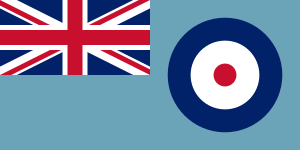No. 534 Squadron RAF
No. 534 Squadron RAF was one of the ten Turbinlite nightfighter squadrons of the Royal Air Force during the Second World War.
| No. 534 Squadron RAF | |
|---|---|
| Active | 2 Sep 1942 – 25 Jan 1943[1] |
| Country | |
| Branch | |
| Role | Turbinlite nightfighter squadron |
| Part of | No. 11 Group RAF, Fighter Command[2] |
History
No. 534 Squadron was formed at RAF Tangmere, Sussex on 2[1] September 1942, from No. 1455 (Turbinlite) Flight,[3][4] as part of No. 11 Group RAF in Fighter Command. Instead of operating only Turbinlite and -rudimentary- Airborne Intercept (AI) radar equipped aircraft (Havocs and Bostons) and working together with a normal nightfighter unit the unit now also flew with their own Hawker Hurricanes. It was disbanded at Tangmere on 25 January 1943,[1] when Turbinlite squadrons were, due to lack of success on their part and the rapid development of AI radar, thought to be superfluous.[5]
Aircraft operated
| From | To | Aircraft | Version |
|---|---|---|---|
| 2 September 1942 | 25 January 1943 | Douglas Havoc | Mk.I (Turbinlite) |
| 2 September 1942 | 25 January 1943 | Douglas Havoc | Mk.II (Turbinlite) |
| 2 September 1942 | 25 January 1943 | Douglas Boston | Mk.I (Nightfighter) |
| 2 September 1942 | 25 January 1943 | Douglas Boston | Mk.III (Turbinlite) |
| 2 September 1942 | 25 January 1943 | Hawker Hurricane | Mk.IIc |
Squadron bases
| From | To | Base |
|---|---|---|
| 2 September 1942 | 25 January 1943 | RAF Tangmere, Sussex |
Commanding officers
| From | To | Name |
|---|---|---|
| 2 September 1942 | 25 January 1943 | S/Ldr. K. Matthews |
gollark: Except conlangs, which are weird in precisely defined ways, typically.
gollark: All languages are weird.
gollark: More like 701%.
gollark: One of the cool things about Iceland is that you can in fact wear sunglasses at times normally considered night, due to the weird day/night cycle.
gollark: I mean, dares are quite stupid anyway.
References
Notes
- Jefford 2001, p. 97.
- www.rafcommands.com
- Rawlings 1978, p. 465.
- Sturtivant and Hamlin 2007, p. 123.
- Halley 1988, p. 402.
Bibliography
- Delve, Ken. The Source Book of the RAF. Shrewsbury, Shropshire, UK: Airlife Publishing, 1994. ISBN 1-85310-451-5.
- Flintham, Vic and Andrew Thomas. Combat Codes: A full explanation and listing of British, Commonwealth and Allied air force unit codes since 1938. Shrewsbury, Shropshire, UK: Airlife Publishing, 2003. ISBN 1-84037-281-8.
- Halley, James J. The Squadrons of the Royal Air Force & Commonwealth 1918–1988. Tonbridge, Kent, UK: Air Britain (Historians), 1988. ISBN 0-85130-164-9.
- Jefford, C.G. RAF Squadrons, a Comprehensive record of the Movement and Equipment of all RAF Squadrons and their Antecedents since 1912. Shrewsbury, Shropshire, UK: Airlife Publishing, 1988 (second edition 2001). ISBN 1-85310-053-6.
- Rawlings, John D.R. Fighter Squadrons of the RAF and their Aircraft. London: Macdonald & Jane's (Publishers), 1969 (2nd edition 1976, reprinted 1978). ISBN 0-354-01028-X.
- Sturtivant, Ray, ISO and John Hamlin. RAF Flying Training And Support Units since 1912. Tonbridge, Kent, UK: Air-Britain (Historians), 2007. ISBN 0-85130-365-X.
External links
This article is issued from Wikipedia. The text is licensed under Creative Commons - Attribution - Sharealike. Additional terms may apply for the media files.
